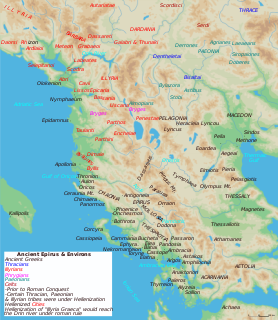
Seuthopolis was an ancient hellenistic-type city founded by the Thracian king Seuthes III between 325–315 BC and the capital of the Odrysian kingdom.

Gitanae or Gitana, or Gitona (Γίτωνα), or Titana, was a city of ancient Epirus, described by Livy as being near Corcyra, and about 10 miles from the coast. as a place of meeting of the Epirote League. It is not mentioned by any other ancient writer, and it was conjectured that the word is a corrupt form of Chyton, which Ephorus spoke of as a place in Epirus colonised by Ionians from Klazomenai.
Thronion or Thronium was a Greek city of the Euboians and Locrians in the border area between Illyria and Epirus, near Amantia. It is believed to lie somewhere to the south of Vlorë, between the Shushicë River and the sea. Some scholars, such as Hasan Ceka and Nicholas G.L. Hammond, have proposed Kaninë as the possible location. R.L. Beaumont, in addition to Kanina, also suggested Ploça and Klos. It was to have been founded after the Trojan War by the Abantes of Euboea and the inhabitants of the Locrian Thronium. It was taken at an early period by the inhabitants of the neighbouring town of Apollonia, and annexed to their territory, as appears from an epigram inscribed on a dedicatory offering of the Apolloniatae at Olympia.

Toryne, also known as Torone (Τορώνη), was a city of ancient Thesprotia in ancient Epirus. The fleet of Augustus was moored off Toryne a short time before the Battle of Actium, and seems from the order of the names in Ptolemy to have stood in one of the bays between the mouth of the river Thyamis and Sybota. It was located on the Ionian Sea coast, and its site is tentatively placed near present Parga.

Berenice or Berenike was a Greek city in the region of ancient Epirus, near current Preveza. It was founded by Pyrrhus II of Epirus.

Kanali is a seaside village and a community in the Preveza regional unit, northwestern Greece. It was the seat of the former municipality Zalongo. The community consists of the villages Kanali, Kastrosykia, Mazi, Nea Thesi and Pidima Kyras. Kanali is situated on the Ionian Sea coast, 13 km north of Preveza.

Bouneima was an ancient Greek city in the region of Macedonia (region), Tymphaea, said to have been founded by Odysseus

Ilium or Ilion, also known as Troja (Τροΐα), was a city of ancient Epirus. It is mentioned in the Aeneid of Virgil as a foundation of Helenus after the Trojan War in the land of the Chaonia.

Cheimerium or Cheimerion was a fortified settlement and harbour of ancient Thesprotia in ancient Epirus, on an eponymous promontory. It lay between the rivers Acheron and Thyamis, and opposite the southern point of Corcyra. In the two naval engagements between the Corcyraeans and Corinthians just before the Peloponnesian War, Cheimerium was the station of the Corinthian fleet.

Elina was an ancient Greek, Hellenistic fortified town in the region of Epirus.

Pale was an ancient Greek city in ancient Cephalonia. In 435 BCE Pale supported Corinth against Corcyra by sending four ships. Its territory was called Paleis (Παλείς).

Same was a Greek city in ancient Cephalonia.

Ithaca, Ithake, or Ithaka was a Greek city on ancient Ithaca.
Datus or Datos, also Datum or Daton, was an ancient Greek city located in Macedonia, specifically in the region between the river Strymon and the river Nestos. It was founded by colonists from Thasos at 360 BCE, with the help and support of the Athenian exiled orator Callistratus of Aphidnae. Datos was a seaport, close to Mount Pangaion with its rich gold veins and to another Thasian colony, Crenides. The two colonies provoked the Thracians but at the same time gave Philip II of Macedon the justification for penetrating the area and founding Philippi in 356 BCE. The name was also applied to a wide region. There was some conjecture that Datus was the same as the later Neapolis, A proverb current in antiquity celebrated Datus for its "good things."

Crenides or Krenides was an ancient Greek city located in Thrace, and later in ancient Macedonia located in the region between the river Strymon and the river Nestos. It was founded by colonists from Thasos in 360 BCE. Crenides was close to Mount Pangaion with its rich gold veins and to another Thasian colony, Datos. The two colonies provoked the Thracians but at the same time gave Philip II of Macedon the justification for penetrating the area and founding Philippi in 356 BCE. Philip intervened to protect the city when it was threatened by Thracians under Kersobleptes.
Sirra or was an ancient Greek polis located in Thrace, in the region between the river Strymon and the river Nestos. The city ethnic name was or and its territory was called. Sirra was located in the territory of the Odomantes.
Larissa was an ancient Greek city located in Thrace, located in the region between the river Nestos to the river Hebros. Larissa was located in the borderland between Elis and Achaian Dyme. It remains unlocated and unidentified.

Euripus or Euripos was a town in ancient Acarnania. It is known mainly through epigraphic evidence, including the appointment of theorodokoi of the place is mentioned towards the year 356/5 BCE to host theoroi of Epidaurus and also in another entry dated in the period 331/0-313 BCE to receive the theoroi of Nemea. It was a member of the Acarnanian League in the 3rd century BCE. It is also mentioned in the Periplus of Pseudo-Scylax.






